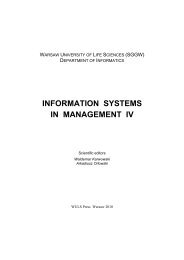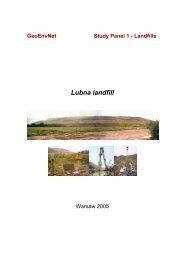ACTA SCIENTIARUM POLONORUM - SGGW
ACTA SCIENTIARUM POLONORUM - SGGW
ACTA SCIENTIARUM POLONORUM - SGGW
You also want an ePaper? Increase the reach of your titles
YUMPU automatically turns print PDFs into web optimized ePapers that Google loves.
110 E. SzymańskaProducts by Activity in the European Economic Community, 2008 version). The neededdata derives from the category “Economic entities” of GUS Local Date Base. Data referringnatural and anthropological values were taken form the category “EnvironmentalProtection” and “Forestry” of GUS Lokal Data Base as well as form the data base of TheNational Heritage Board of Poland. All data come from the year 2009.TOURISM FUNCTION THEORYIn the literature two approaches to the tourism function issue can be distinguished.The first one is the classical approach (narrow one), which refers to economic meaningof tourism function. Warszyńska and Jackowski [1979] describe areas with tourismfunction as territorial units in which tourism plays a dominating role in its economy.The same as areas with industrial or agricultural function, there are areas with significanttourism function, which can be described as tourist regions [Derek 2008]. Matczak[1989] or Kurek and Mika [2007] express tourism function as socio-economic activityof an area which is directed into tourism services. Another example is an approach proposedby Baretje and Defert [1972] that claim that areas with tourism function can beconsidered as territorial units where employment in tourism business constitutes morethen 50% of the total employment [Cooper 2009]. However, such a approach is connectedwith difficulties concerning the measures. First of all, it is complicated to separateemployment in trade and services directed only to tourists from the one directedto the residents. Secondly, the precise statistical data in this aspect are very limited.Though, oversimplifying this concept in polish conditions, the tourism function can beevaluate by comparing the employment in section I – Accommodation and Food Service(according to PKD classification) to the total employment in the researched area.More applicable is approach proposed by Defert [1967] which refers tourism functionto number of beds per capita. Some authors take into account also the numbers of touristsaccording to the number of residents or an area [Derek 2008].The second approach to the tourism function theory is new (broad) one, which assumesthat evaluation of tourism function of an area has to be more complex. Except ofsocio-economic aspect, the others factors like tourism infrastructure, tourism movementor tourism values are relevant. This approach reflects fully the character of tourism functionissue. Derek [2008] underlines the fact that tourism function is developed only wheneach of three factors are highlighted, what illustrates Figure 1.Fischbach [1989] claims, that by evaluating tourism function of an area even moreaspects has to be considered and names seven groups of factors: tourism values, tourisminfrastructure, communication availability, tourism movement (scale and structure),land use, incomes coming from tourism sector, and employment (scale and structure).Summing up, it can be ascertain that the area with fully developed tourism functionis an area distinguished by tourism values and infrastructure and reflecting relative hightourism movement.Acta Sci. Pol.
















